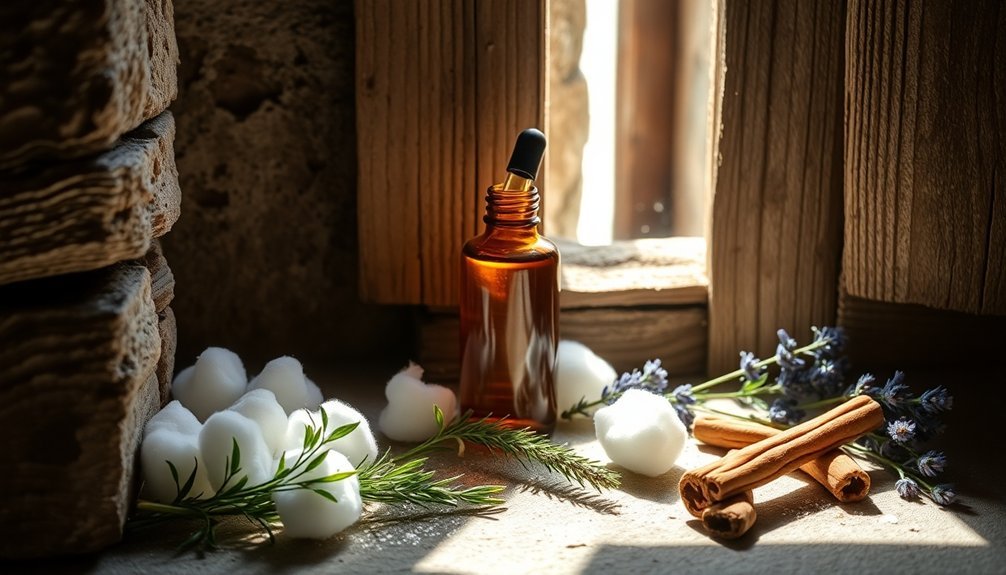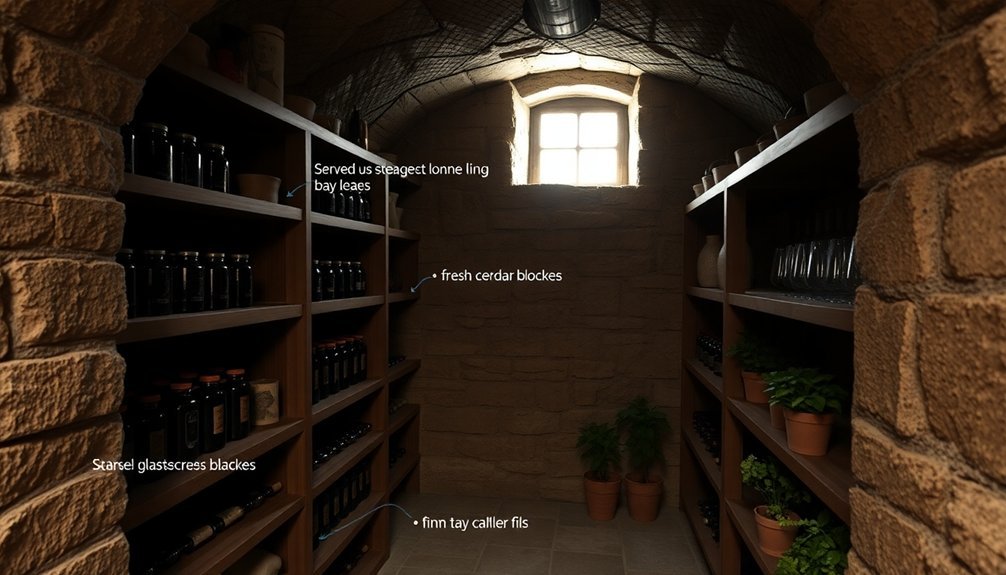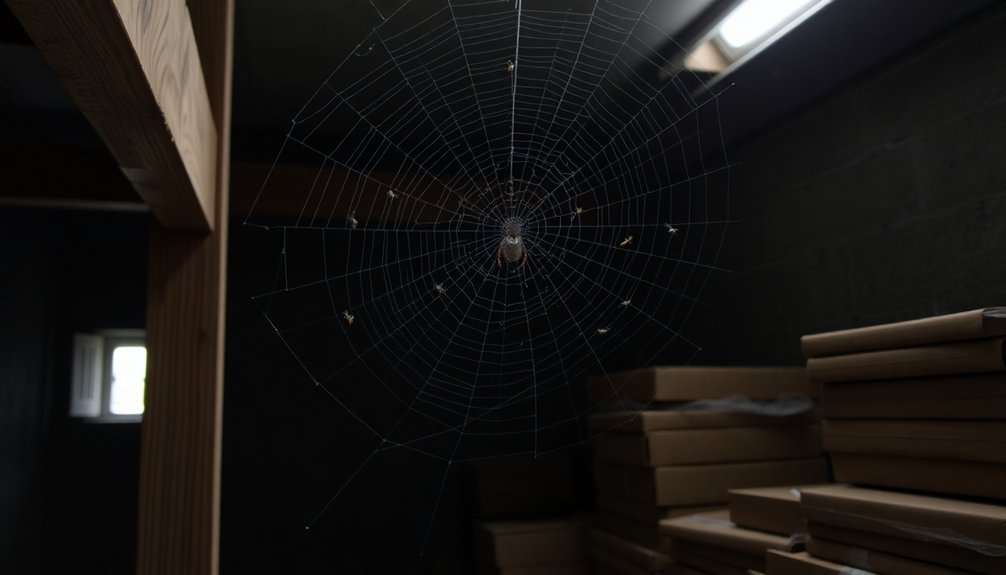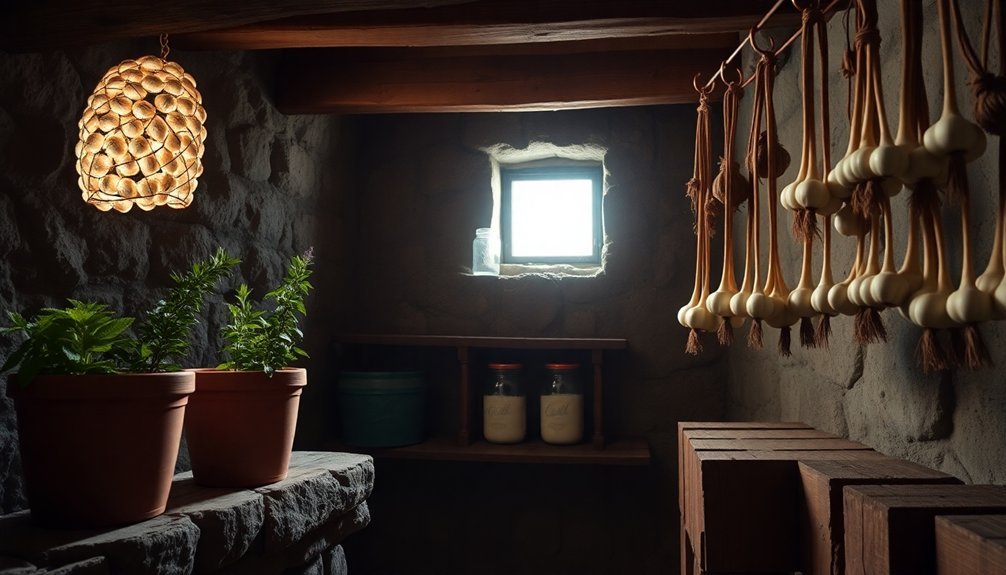You'll achieve effective pest control in your cellar through ten natural methods that work together. Start by creating barriers with peppermint oil-soaked cotton balls and strategic herb plantings near entry points. Store all food in airtight containers and maintain proper moisture levels with dehumidifiers. Implement cross-ventilation to prevent dampness, and use diatomaceous earth along baseboards. Set up zones with natural repellents like bay leaves and cloves, while managing beneficial spiders to control flying pests. Don't forget to seal gaps with caulk and establish perimeter plantings of marigolds and citronella. These chemical-free solutions offer just the beginning of your pest-free cellar journey.
Essential Oil Pest Defense

If you're looking for a natural way to defend your cellar against unwanted pests, essential oils offer a powerful and non-toxic solution. Peppermint oil stands out as a particularly effective deterrent, with studies showing it achieves a 97% mortality rate against brown-banded cockroaches within 24 hours. Its strong aroma acts as a natural deterrent for both cats and dogs, making it ideal for homes with pets. It's also highly effective against spiders, mice, ants, and fleas.
You can implement an essential oil defense system using two primary methods. First, saturate cotton balls with peppermint oil and place them strategically around your cellar's entry points, crawl spaces, and corners.
Second, create a DIY spray solution by mixing 2 teaspoons of peppermint oil with 2 tablespoons of liquid soap in a gallon of warm water.
For enhanced protection, consider incorporating other potent essential oils into your pest control strategy. Citrus oils work well against spiders, while citronella serves as an EPA-registered repellent for various insects. Cedarwood oil proves especially effective against ticks and is safe for households with children and pets.
You'll need to replenish your cotton balls and reapply spray solutions regularly to maintain a strong pest barrier.
Strategic Food Storage Methods
Through proper food storage techniques, you'll create an environment that keeps pests away while preserving your cellar's contents. Start by transferring your food items into airtight containers made of glass, metal, or heavy-duty plastic. These containers, especially those with screw-on lids or tight-fitting seals, create an impenetrable barrier against unwanted visitors.
Choose your storage location wisely by keeping food in cool, dry areas where pests are less likely to thrive. Basements and crawlspaces offer natural cool conditions, while proper ventilation prevents ethylene gas buildup. Using untreated wood shelving helps avoid harmful chemical exposure to stored foods. You'll want to keep items elevated on shelves to make access difficult for pests.
- Check your stored items weekly for signs of pest activity, including gnaw marks, holes, or webbing.
- Remove any compromised items immediately to prevent pest spread.
- Maintain a clean storage area by sweeping regularly and wiping down shelves.
Don't forget to implement a rotation system using the "first in, first out" rule. Organize your items in clearly marked bins and shelves, making it easier to track expiration dates and maintain proper inventory control.
Regular maintenance and organization are your best defenses against pest invasions.
Herbal Repellent Zones

You'll want to start your cellar's pest defense by creating strategic zones of potent herbal repellents, placing containers of mint and basil near entry points while positioning rosemary and lavender along storage areas.
Your first power zone should focus on doorways and windows, where you can combine both growing herbs and essential oil treatments for maximum effectiveness. These herbs can be placed in hanging baskets to maximize vertical space while providing continuous pest protection.
Consider establishing a second defensive zone around your food storage areas using hardy herbs like chives and thyme, which thrive in lower-light conditions while naturally deterring common cellar pests.
Strategic Herb Placement Guide
Strategic placement of herbal repellents can transform your cellar into a pest-resistant fortress.
You'll want to focus on key areas where pests commonly enter and gather, creating barriers that maximize the herbs' natural repelling properties. By combining different herbs strategically, you'll create a more thorough defense system against various unwanted visitors.
- Place peppermint-soaked cotton balls near windows, doorways, and any small cracks where mice might enter, then supplement these entry points with crushed garlic cloves for an extra layer of protection.
- Line your storage shelves with bay leaves and sage, especially where you keep grains and root vegetables, and refresh these herbs monthly to maintain their potency.
- Position lavender and lemongrass bundles in corners and areas with good air circulation, focusing particularly on humid zones where pests tend to gather.
Remember to inspect your herbal barriers weekly and replace them when their scent begins to fade.
You can enhance their effectiveness by combining complementary herbs, such as peppermint with garlic or bay leaves with sage.
Don't forget to adjust your placement strategy seasonally, as pest activity often changes with the weather.
Natural Repelling Power Zones
Building on our herb placement strategy, understanding natural repelling power zones takes pest control to the next level. You'll want to create distinct zones throughout your cellar, each utilizing specific herb combinations for maximum effectiveness.
Start with your entry points by creating a barrier zone. Soak cotton balls in peppermint oil and combine them with ground cloves near doorways and windows.
In your storage areas, establish protection zones by placing bay leaves in bins and hanging garlic bulbs nearby. Don't forget to maintain proper airflow in these zones to enhance the herbs' effectiveness.
Create a perimeter zone by planting marigolds and citronella grass outside your cellar's foundation.
Inside, set up moisture-controlled zones where you'll combine rosemary and lavender with oscillating fans to keep the area dry and pest-free.
For your food storage zone, use airtight containers and sprinkle dried herbs like basil and chives around the shelving units.
Remember to establish monitoring zones at strategic points where you'll place humane traps alongside your herbal deterrents.
You can boost each zone's effectiveness by adding cayenne pepper to your herb combinations, especially in areas where you've noticed rodent activity.
Natural Ventilation Systems
Proper ventilation in your cellar starts with cross-flow air movement, which you'll achieve by strategically placing windows or vents on opposite walls to create a continuous stream of fresh air.
You can enhance this airflow through stack ventilation, where warmer air naturally rises and exits through higher openings while drawing in cooler air from lower vents.
Well-designed window wells with proper drainage and adequate depth not only prevent water accumulation but also maximize your cellar's natural airflow, making it less appealing to pests seeking dark, stagnant spaces.
Cross-Flow Air Movement
Natural ventilation's cross-flow air movement provides an energy-efficient solution for keeping your cellar pest-free and well-ventilated. By strategically placing windows or vents on opposite walls, you'll create a natural pathway for air to flow through your cellar, driven by wind pressure differences.
This setup allows fresh air to enter through the windward side and exit through the downwind side, effectively removing stale air, excess moisture, and potential pest-attracting odors.
To maximize cross-flow ventilation in your cellar:
- Install windows or vents on opposing walls to create a direct path for air movement, ensuring the incoming air flows perpendicular to your cellar's layout.
- Position openings to take advantage of prevailing wind patterns, with intake vents on the high-pressure windward side and exhaust vents on the low-pressure downwind side.
- Keep all vents clear of obstruction and properly screened to prevent pest entry while maintaining ideal airflow.
This natural ventilation system reduces mold proliferation and maintains healthier air quality without relying on mechanical systems.
You'll benefit from lower energy costs while creating an environment that's naturally inhospitable to pests through proper air circulation and moisture control.
Stack Ventilation Benefits
Stack ventilation's effectiveness in pest control complements cross-flow ventilation by creating a powerful upward air movement that discourages pest activity. You'll find this natural ventilation method particularly useful in your cellar, as it works continuously without mechanical assistance to maintain air quality and deter pests.
By installing vents at both low and high points in your cellar, you're creating a natural chimney effect that draws fresh air through while expelling stale air. This constant movement helps prevent moisture buildup that attracts pests and makes it harder for them to establish colonies.
| Benefit | Pest Control Impact | Implementation |
|---|---|---|
| Thermal Flow | Disrupts insect movement patterns | Install high/low vents |
| Moisture Control | Reduces conducive conditions | Add self-regulating vents |
| Continuous Operation | Maintains constant pest deterrence | Design proper stack height |
| Power Independence | Works during outages | Include filtered openings |
You'll save money while keeping pests at bay, as stack ventilation requires no electricity and minimal maintenance. The system's effectiveness increases with proper stack height, and you can enhance its performance by adding filtered openings to prevent dust and larger insects from entering. During winter, you'll need to monitor ventilation rates to prevent excessive heat loss while maintaining adequate pest control.
Window Well Design
With effective window well design, you'll create an essential component of your cellar's natural ventilation system. Properly designed window wells help remove stale air, reduce moisture, and lower radon concentrations, making your cellar a healthier space.
When you strategically place your windows and incorporate vented covers, you'll maximize natural airflow while minimizing the need for mechanical ventilation systems.
To optimize your window well design for natural ventilation, consider these key elements:
- Choose the right size and shape for your wells, guaranteeing they're large enough to allow adequate airflow through your basement windows while accounting for surrounding obstacles.
- Install vented window well covers that allow fresh air circulation while protecting against debris and precipitation.
- Position multiple windows strategically to create cross-ventilation, allowing air to flow naturally through your cellar space.
Select materials like metal or fiberglass based on your specific needs, and maintain regular inspections to guarantee your ventilation system continues working effectively.
You'll find that proper window well design not only improves air quality but also helps prevent structural damage and mold growth while enhancing your cellar's overall comfort level.
Cellar Organization Techniques

Effective cellar organization serves as the foundation for protecting your wine collection from pests while guaranteeing easy access to your favorite bottles.
You'll want to start by implementing a systematic approach that combines geographical, varietal, and vintage-based organization methods.
Create distinct sections in your cellar based on wine regions, which will help you track and monitor your collection more efficiently. Within each regional section, arrange your wines by varietal and vintage, using a grid system to assign specific locations to each bottle.
Don't forget to install additional wine racks and utilize vertical space to maximize storage capacity while maintaining proper airflow.
Label each bottle clearly with essential details including region, varietal, vintage, and tasting notes. You can use a wine inventory app to track aging potential and consume-by dates.
For peak pest prevention, store any non-wine items in airtight containers, and regularly rotate your wines to inspect for any signs of pest activity.
When organizing by vintage, keep older wines separate from newer additions, making it easier to monitor their aging process and guarantee they're stored in peak conditions.
This systematic approach won't just protect your collection—it'll enhance your overall wine experience.
Moisture Control Fundamentals
Maintaining proper moisture control throughout your cellar stands as the cornerstone of pest prevention and wine preservation. You'll need to identify and address potential moisture sources quickly, including leaking pipes, condensation issues, and poorly sealed windows.
Install a high-quality dehumidifier to keep humidity levels between 30-50%, and guarantee your ventilation system effectively removes excess moisture while preventing rodent entry through quarter-inch hardware cloth covers.
To create an effective moisture barrier system in your cellar, you'll want to:
- Install thick plastic vapor barriers on soil surfaces, extending them up foundation walls and securing them with specialized moisture-resistant tape.
- Apply moisture-locking paint products to your foundation walls, creating an additional barrier against water infiltration.
- Grade the floor properly and install appropriate drainage systems, including sump pumps if necessary.
Don't forget to regularly inspect and document moisture readings using a hygrometer. Remove any debris that could trap moisture, and replace damaged insulation promptly.
If you notice signs of mold or fungal growth, treat affected areas with appropriate products like Mold-Clean® or Bora-Care® to maintain a clean, dry environment.
Carnivorous Plant Guardians

While moisture control protects your cellar's foundation, some homeowners explore natural pest control methods like carnivorous plants. However, you shouldn't rely on these plants as your primary pest control strategy.
Despite their fascinating nature, carnivorous plants aren't particularly effective at controlling large insect populations in cellar environments.
If you're considering pitcher plants, Venus flytraps, or sundews for your cellar, be aware of their demanding care requirements. These plants need specific conditions, including high humidity and proper lighting, which can actually create new problems in your cellar.
The standing water they require might even attract mosquitoes, making your pest situation worse.
You'll need to provide UVB lighting and maintain precise temperature control for these plants to survive. Even then, they'll only catch occasional flies or fungus gnats, not enough to address a serious infestation.
While they might work as part of a broader pest management approach, they're more decorative than functional.
If you're dealing with cellar pests, you'll want to focus on more effective methods like sealing entry points, reducing moisture, and maintaining proper ventilation instead of relying on carnivorous plants.
Diatomaceous Earth Applications
A natural and powerful pest control solution, diatomaceous earth offers cellar owners a safe way to combat crawling insects. This fine powder works by damaging insects' protective outer layer and causing dehydration, making it particularly effective against common cellar pests like ants, beetles, and cockroaches.
To protect your cellar effectively with diatomaceous earth, you'll need to apply it strategically:
- Spread a thin line along your cellar's baseboards, windowsills, and entry points, creating a barrier that insects can't cross without fatal contact.
- Apply directly to visible ant trails or areas where you've spotted pest activity, ensuring thorough coverage of their travel paths.
- Dust the powder around storage containers and shelving units where beetles or cockroaches might hide.
Remember to wear a protective mask and goggles during application, as the fine particles can irritate your lungs and eyes.
You'll want to use only food-grade diatomaceous earth in your cellar, especially if you're storing food items.
Since moisture reduces its effectiveness, you'll need to reapply after any water exposure or in particularly humid conditions.
Beneficial Spider Management

Beyond chemical and natural deterrents like diatomaceous earth, smart cellar management includes understanding which creatures can actually help control pests.
Cellar spiders, in particular, play an essential role in maintaining a balanced ecosystem by preying on various household pests, including gnats, flies, moths, mosquitoes, and even dangerous spiders like black widows.
While you'll want to manage their population, you don't need to eliminate cellar spiders entirely. Instead, focus on controlling their presence through non-invasive methods.
You can use a vacuum to remove excess webs and egg sacs, and keep your space tidy to reduce potential hiding spots. Installing dehumidifiers and ensuring proper ventilation will make your cellar less appealing to these arachnids.
If you'd like to discourage spider activity in specific areas, try natural deterrents like eucalyptus oil or diluted white vinegar solutions.
You'll also want to seal entry points around doors and windows, replace exterior white lights with yellow ones, and store items away from walls.
Natural Barrier Solutions
Creating effective natural barriers starts with a thorough approach to sealing and cleaning your cellar space. You'll want to caulk all gaps and potential entry points while maintaining a clean, dry environment that doesn't attract unwanted visitors. By storing food items on elevated shelves or pallets, you're creating a natural barrier that makes it harder for pests to access your supplies.
- Layer your defense with cotton balls soaked in peppermint oil around windows and doorways, while strategically placing bay leaves near grain storage and root vegetables.
- Create a protective perimeter using citrus-based solutions and basil plants, which naturally repel flying insects and crawling pests.
- Set up multiple barrier zones using borax or castile soap solutions along baseboards and entry points, complemented by baking soda in corners and crevices.
For maximum effectiveness, combine these natural barriers with proper ventilation and humidity control. You can enhance your barrier system by using airtight containers for food storage and maintaining a clear zone around your cellar's exterior by trimming vegetation and eliminating standing water sources.
This multi-layered approach creates an inhospitable environment for pests while keeping your cellar naturally protected.
Frequently Asked Questions
How Long Does It Take to See Results From Natural Pest Control Methods?
You'll notice immediate effects from natural repellents, while most methods take 1-4 weeks for significant results. For complete pest control, expect 1-3 months, with ongoing maintenance needed for long-term effectiveness.
Can Natural Pest Repellents Harm Stored Vegetables or Fruits?
No, natural pest repellents won't harm your stored produce when used correctly. You'll want to keep them separate from your fruits and vegetables, and guarantee good air circulation for the best results.
Should I Remove Existing Spider Webs Before Implementing Natural Pest Control?
Yes, you'll need to remove existing spider webs before using natural pest control. It helps identify entry points, prevents re-infestation, and makes your deterrents more effective by eliminating established spider territories.
How Often Should Natural Pest Deterrents Be Replaced or Refreshed?
You'll need to refresh essential oils and vinegar sprays every few days, replace natural traps monthly, and reapply diatomaceous earth every 1-2 months. Don't forget to maintain herbal plants and barriers regularly.
What Temperature Range Is Ideal for Maintaining Natural Pest Control Effectiveness?
You'll want to maintain your home's temperature between 68-72°F to effectively deter pests. This range slows insect development while keeping humidity levels ideal. It's especially effective when combined with natural deterrents.
In Summary
You've now got all the tools you need to maintain a pest-free cellar naturally. By combining these methods – from essential oils and strategic storage to beneficial spiders and diatomaceous earth – you'll create multiple lines of defense against unwanted visitors. Remember to check and maintain these natural solutions regularly, and you'll enjoy a clean, pest-resistant storage space without relying on harmful chemicals.





Leave a Reply